| Srl | Item |
| 1 |
ID:
124476
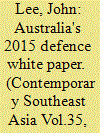

|
|
|
|
|
| Publication |
2013.
|
| Summary/Abstract |
Australia's new government is committed to delivering the next defence white paper in 2015. The two previous white papers took a predominantly risk-management approach to Southeast Asia, generally ignored the strategic opportunities in the region, treated it as a stand-alone region largely unrelated to developments in East Asia and failed to link Australia's policies in Southeast Asia with the broader goal of helping to ensure greater strategic stability in Asia by putting constraints on Chinese assertiveness and encouraging its peaceful rise. After offering a summary of recent Australian defence thinking on Southeast Asia, this paper outlines why managing China is the key variable when it comes to strategic stability in the region. It then examines how China's strategy and behaviour can be shaped and influenced by events and relationships in Southeast Asia, and offers some suggestions as to the role Australia can seek to play in Southeast Asia that relates to Canberra's China-focused objectives and strategic stability in Asia more broadly. If that can be achieved in the 2015 defence white paper, Australia - which is often criticized for being preoccupied primarily with managing the relationship with its superpower ally the United States - will demonstrate to itself and Asia that its heavy reliance on the ANZUS treaty is no barrier to strategic creativity in Asia.
|
|
|
|
|
|
|
|
|
|
|
|
|
|
|
|
| 2 |
ID:
101561
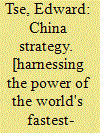

|
|
|
|
|
| Publication |
New York, Basic Books, 2010.
|
| Description |
247p.
|
| Standard Number |
9780465018253, hbk
|
|
|
|
|
|
|
|
|
|
|
|
Copies: C:1/I:0,R:0,Q:0
Circulation
| Accession# | Call# | Current Location | Status | Policy | Location |
| 055612 | 330.973/TSE 055612 | Main | On Shelf | General | |
|
|
|
|
| 3 |
ID:
089066


|
|
|
|
|
| Publication |
2009.
|
| Summary/Abstract |
For almost four decades, China has disputed Japan's sovereignty of several small rocky islands in the East China Sea. Despite a June 2008 joint gas development agreement, China continues to claim sovereignty and the dispute is nowhere close to being resolved. This study proposes that China benefits from the endurance of the dispute because it can use territorial dispute threats to compel Japan to change its behavior or policy on other disputed issues. The results show that China gained concessions on other issues by using the territorial dispute as bargaining leverage in most of the 26 threats made between 1978 and 2008.
|
|
|
|
|
|
|
|
|
|
|
|
|
|
|
|
| 4 |
ID:
089245


|
|
|
| 5 |
ID:
147610
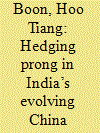

|
|
|
|
|
| Summary/Abstract |
This article addresses Sino–Indian relations from the alternative and under-engaged lens of hedging, as opposed to the more conventional balancing and bandwagoning dichotomy. It analyzes why and how, despite the general stable state of and progress in Sino–Indian relations, Delhi has pursued a hedging strategy against China. Under the present Modi administration, India has not deviated markedly from its traditionally prudent foreign policy approach towards China. Yet, there have been discernible changes and, arguably, the main departure from the previous government’s policy is a matter of degree: a more consolidated hedging component combined with a more robust engagement policy towards China. Like several countries in the Indo–Pacific confronted with the rise of China, India remains strategically ambivalent about China.
|
|
|
|
|
|
|
|
|
|
|
|
|
|
|
|
| 6 |
ID:
104644
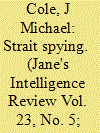

|
|
|
| 7 |
ID:
138167


|
|
|
|
|
| Summary/Abstract |
Under what conditions would a great power adopt a general strategy or selective strategies towards multiple weaker targets? This article seeks to answer the question through conceptual, theoretical, and empirical contributions. First, the essay discusses the conceptual significance of general and selective strategies in multilateral asymmetry. Second, the conventional wisdom suggests that external threats and domestic politics explain a great power’s foreign policy. Such theories may indeed explain certain types of foreign policy, but this article raises a structural theory to account for a great power’s multilateral asymmetric strategies, wherein regional structures and alignment relationships best explain the particular type of a great power’s foreign conduct. Third, the essay challenges the conventional wisdom whereby US–Soviet bipolarity in Cold War Europe was applicable to Cold War Asia. Based upon newly available Chinese, Russian, and American archives, China’s consistent behaviour in maritime East Asia and Indochina (1949–1982) demonstrates the virtues of a structural theory, and exposes the limits of alternative explanations.
|
|
|
|
|
|
|
|
|
|
|
|
|
|
|
|
| 8 |
ID:
124468
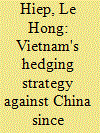

|
|
|
|
|
| Publication |
2013.
|
| Summary/Abstract |
Since the normalization of Sino-Vietnamese relations in 1991, Vietnam's China policy has been shaped by a combination of approaches which can be best described as a multi-tiered, omni-directional hedging strategy. The article argues that hedging is the most rational and viable option for Vietnam to manage its relations with China given its historical experiences, domestic and bilateral conditions, as well as changes in Vietnam's external relations and the international strategic environment. The article examines the four major components of this strategy, namely economic pragmatism, direct engagement, hard balancing and soft balancing. The article goes on to assess the significance of each component and details how Vietnam has pursued its hedging strategy towards China since normalization.
|
|
|
|
|
|
|
|
|
|
|
|
|
|
|
|